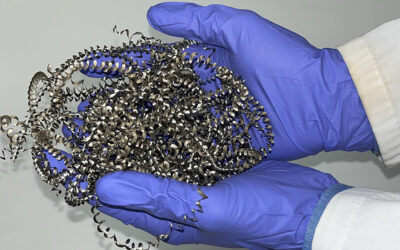Turning lignin, a plant’s structural “glue” and a byproduct of the paper and pulp industry, into something considerably more valuable is driving a research effort headed by Amit Naskar of Oak Ridge National Laboratory.
In a new publication, the research team describes a process that ultimately transforms the lignin byproduct into a thermoplastic – a polymer that becomes pliable above a specific temperature. Researchers accomplished this by reconstructing larger lignin molecules either through a chemical reaction with formaldehyde or by washing with methanol. Through these simple chemical processes, they created a crosslinked rubber-like material that can also be processed like plastics.
“Our work addresses a pathway to utilize lignin as a sustainable, renewable resource material for synthesis of thermoplastics that are recyclable,” said Naskar, a member of the Department of Energy laboratory’s Material Science and Technology Division.
Instead of using nearly 50 million tons of lignin byproduct produced annually as a low-cost fuel to power paper and pulp mills, the material can be transformed into a lignin-derived high-value plastic. While the lignin byproduct in raw form is worth just pennies a pound as a fuel, the value can potentially increase by a factor of 10 or more after the conversion.
Naskar noted that earlier work on lignin-based plastics utilized material that was available from pulping industries and was a significantly degraded version of native lignin contained in biomass. This decomposition occurs during harsh chemical treatment of biomass.
“Here, however, we attempted to reconstruct larger lignin molecules by a simple crosslinking chemistry and then used it as a substitute for rigid phase in a formulation that behaves like crosslinked rubbers that can also be processed like plastics,” Naskar said.
Crosslinking involves building large lignin molecules by combining smaller molecules where formaldehyde helps to bridge the smaller units by chemical bonding. Naskar envisions the process leading to lower cost gaskets, window channels, irrigation hose, dashboards, car seat foam and a number of other plastic-like products. A similar material can also be made from lignin produced in biorefineries.
















